As iconic and popular as Sega’s Astro City arcade cabinet was when it launched in 1993, I’d honestly never heard of it until this Mini was announced for Japanese release a few months ago at the time of writing! That said, it turned out that while it’s name wasn’t familiar to me, its very functional design was, having been travelling backwards and forwards to Japan for the last twenty years – it’s what Japanese arcades still look like! Its purpose was very functional too – it was designed to take whatever game boards the arcade wanted to throw into it. The Astro City was a refinement of the Aero City multi-purpose cabinet, which was no frills, customisable and very white, which some have suggested was to negate the perception of dark and dingy Japanese arcades back in 1988 when it arrived. This time the original’s 26-inch screen was bumped up to 29-inches, the power consumption was reduced and the whole thing weighed less, but otherwise it was more of the same. The Astro City 2 would refine things again in 1993, launching as a dedicated Virtua Fighter cabinet, but also offering better compatibility with Sega’s 3D polygon-shifting Model 1 board, and also more power supply, audio, visual and controller improvements. A year later, in 1994, they launched the New Astro City for the Sega Model 2 board, which supported texture-mapped polygons and would be known for years to come for the likes of Daytona USA, Sega Rally Championship, Dead or Alive and The House of the Dead.

Fast forward to the summer of 2021, and Sega have given the Astro City Mini a Western release, maintaining that familiar aesthetic in 1/6 scale form, and played arcade operator themselves with the inclusion of 37 games, from the even more familiar to a few that have never seen the light of day outside of the arcades before. The Astro City was the first arcade cabinet to be made from resin, and likewise, the first thing that strikes you with the Mini is the high-gloss, high-quality heavyweight resin build, just like its full-size predecessor. Before you even think of switching it on though, that joystick is demanding you cop a feel, and provides you with instant microswitch-clicking gratification (especially on the diagonals with their double-click), and the six buttons are feeling very nice too, each with their own meaty click and deep downwards motion. Rounding out what’s in the box, you’ve got a USB cable for power, a HDMI cable for output to a TV rather than the built-in screen and an instruction manual that probably says stop talking and start playing… Just one quick note to say you can also buy a bundle with two controllers, and I guess you can buy them separately, and these are smaller D-pad versions that I guess would make playing on a TV more comfortable, though in my set-up, when I’m not using the screen, the TV is right behind my desk and I’m quite happy using the arcade stick and buttons while the console sits in front of me. And, of course, no two-player shenanigans here, with only a 14-year old that wouldn’t be seen dead touching this around the house! There is a Japan-only “Style Kit” available too, which adds an authentic base to the console (with the coin slot acting as money bank), what looks like a customisable marquee panel and a mini stool. Not sure I’d want it raised any more though – the stick is really comfortable where it is!
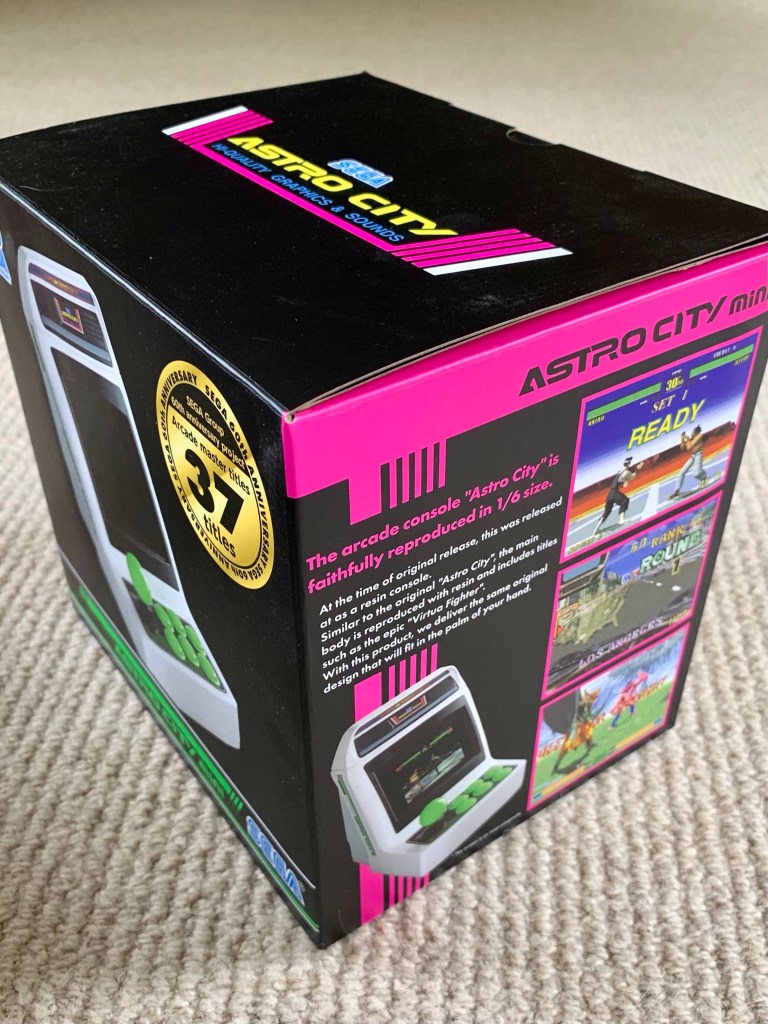
Right, the plan here was to focus on first experiences of playing all of the games rather than reviewing hardware, so we’ll just do a whistlestop tour of the spec… It weighs in at 13 x 17.5 x 17cm, with a 3.9-inch 480×800 LCD screen, offering 16.7M colour depth, or 720 / 480P via HDMI. The screen is a little curious, running at widescreen 16:9 where most of the games are 4:3, so you’ve got borders (albeit customisable ones) down the sides, except in the widescreen menus! I’m really happy playing on the screen though, or on the TV, which does give a clearer image that some games benefit from more than others; Cotton, for example, looks a bit pixellated on the TV compared to the very crisp-looking screen version. One real positive is that I don’t need my glasses when its hooked up to a TV though! I’ll also quickly confirm that with the unit switched on, the arcade stick and buttons still feel great! Actually, they feel really great, with wonderful fidelity and a real arcade feel. Last port of call is the one that headphones plug in to for some improved sound, though again, I’m perfectly happy with the built-in speaker. Audio and visual philistine!
Once you’re connected to USB Power, switching on presents you with a lit green band across the top of the machine, while on the display there’s a Sega logo and Astro City boot screen, and then the games menu appears, totalling about 11-12 seconds. The games are presented as a vertical, numbered carousel that curiously lands on number 33, Virtua Fighter when you turn on, rather than number 1, the far superior Flicky! I get Virtua Fighter first rather than Flicky, but why not make that number 1 instead? We’re in danger of going all Spinal Tap here! On the right hand side of the screen you’re getting some basic information about the game – release year, PCB and genre, as well as some screenshots that you can scroll through with left and right on the stick, which is a nice touch. Pressing start on each title brings up a bit more about the game, as well as instructions and any save states that you want to start from; these are created in-game by pressing the credit and start buttons simultaneously, which will also allow you to load them up, reset the game, go back to the main menu and get a really clear button map for the controls. Back on the main menu, pressing the credit button will bring you the options menu for setting volume, brightness, things like scanlines, wallpapers and so on. And it’s all very intuitive! Right, now the games. All 37 of them, but unlike the menu, I’ll start with number 1 and see what happens from there, if that’s okay!
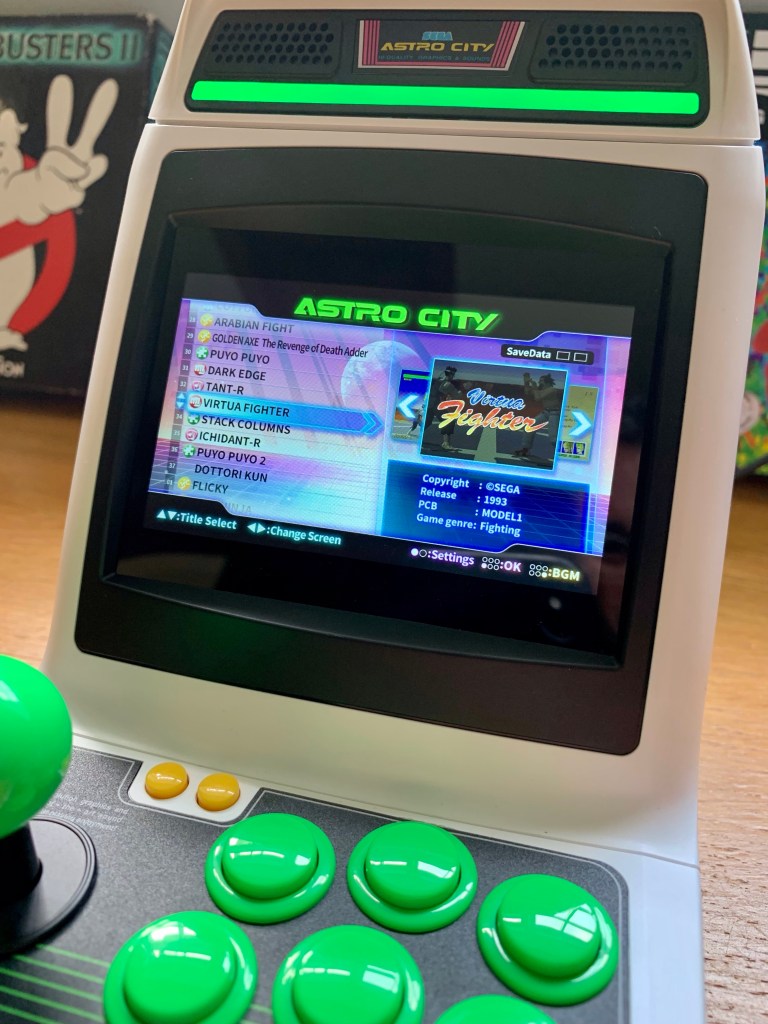
Flicky. What an absolute surprise this was! And despite being number 1 on the menus, because I’d never heard of it, was actually the last of the 37 games I tried, though once I’d fallen in love with it, a bit more digging revealed I actually owned the Mega Drive versions on both the PlayStation 3 and Nintendo Switch Mega Drive Classics compilations, and to my shame had never even loaded it up on either of those! Anyway, this is the debut of Flicky, apparently also in the Sonic series, from 1984, and your job is to “avoid Nyannyan bring the Piyopiyo’s home!” This equates to the happiest, brightest and breeziest game since New Zealand Story or Bubble Bobble, and I choose those comparisons because it’s not a million miles away from either, with your little bird leaping around platforms to gather up chicks and lead them to the exit – the more at once the better – while avoiding and possibly throwing objects at the bad guys trying to stop you. Simple art style, joyful tune, and it controls like an absolute dream, providing the most addictive almost single-screen arcade platforming experience you can imagine! Not quite my number one game on the console, but it’s top three without question.
Sega Ninja. This is like Commando in fairyland, and actually came out the same year as that, in 1985, with you playing Princess Kurumi, using your shuriken and ninja skills to take out the Puma ninjas blocking your path to the castle. A really nice touch with this is that it offers an 8-way shuriken on one button, or a forward (up) only shuriken on another, making the cat and mouse combat with some of the tougher characters far more approachable than being able to throw them any way you want. It has the look of an early JRPG, with loads of pretty pixel trees and rocks and flowers, but make no mistake, it’s a run and gun shooter and a very good one behind that cutesy-looking (and sounding) facade! One thing to note here is the something that’s going to become a bit more problematic later – you’ll notice Japanese text appearing, and while it doesn’t make much difference in Sega Ninja (except I think it says Ninja Princess, its original name), the lack of English ROMs for the Western release does greatly limit enjoyment elsewhere! Interestingly, this was ported to Master System as The Ninja, and can you imagine the uproar if you replaced the original female protagonist with a male ninja out to rescue her today?!?!
My Hero. “Oh no! Takeshi’s girlfriend Mari has been kidnapped. Save her!” I’m starting to love these instructions on the menu screen! This is a like a 2D Double Dragon from 1985, or, indeed, Kung Fu Master dumped into its predecessor Renegade’s world, with urban side-scrolling beat ’em up stylings, complete with almost familiar street gangs. There’s three levels to punch and kick your way through, and then they keep looping until you’re dead. This was a bit of a slow-burn for me, but give it a chance and you’ve got a very fun brawler, with enemies that take some puzzling out and an absolutely gorgeous sunset to behold… I love my gaming sunsets! There’s a couple of nice touches too, like being able to punch projectiles being thrown down on you from above and redirect them at other enemies, or being able to rescue another captive who will then help you fight. Until he’s killed anyway! Possibly not my go-to game on the system, but remember load it up once in a while and you’ll be guaranteed a fun time!
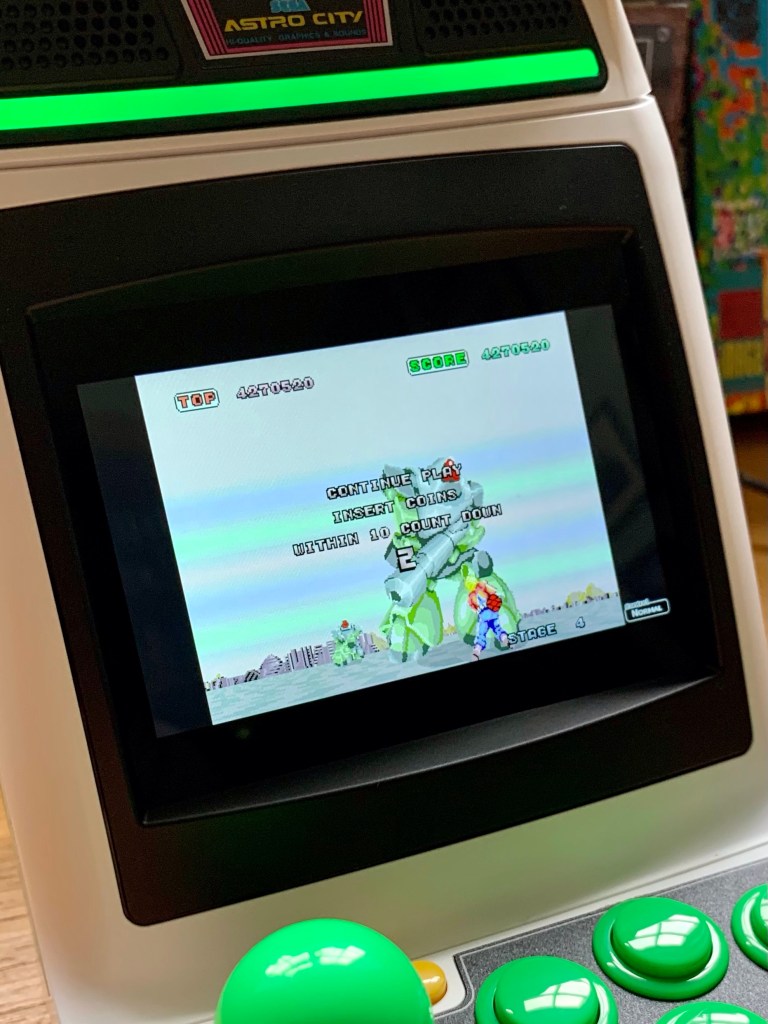
Space Harrier. Now we’re talking! I’ll never forget that mind-blowing sight of the stage one fire-breathing dragon boss the first time I saw it back around 1985. And what a spectacle this game still is! Like everything you’re getting here, it’s worth mentioning that this is the arcade version and not some Mega Drive or something port, but most importantly here, you’ve got the option to change from the inverted default control method! Also worth mentioning another common system feature, the alternate rapid fire version of regular fire mapped to another button, which is a welcome addition to games like this where you’re banging fire non-stop, though for some reason I like banging fire non-stop instead of taking advantage of that! True to form, I can get to the end of stage four here then I die, but I have to say that this is my new favourite place to do so! One more thing, this is the first time I’ve preferred headphones over speakers, just because that iconic soundtrack can get lost to the sound effects otherwise.
Fantasy Zone. Another absolute favourite of mine from 1986, with you side-scrolling in both directions and shooting stuff to collect coins to get power-ups to get further. If Sega Ninja was happy-Commando, this is happy-Defender, with its whimsical colours and enemies and soundtrack disguising tough-as-nails gameplay. Again, the control stick is probably making this my favourite way to play, and there’s a very good chance it might consign Mega Drive Super Fantasy Zone to not being one of my go-to half-time in football on TV games! I could talk about this all day (and pretty much did so here) so as we’ve still got 32 games to go, I’ll move on by saying if you get one of these, just make this one of your first stops!
Wonder Boy. Apart from dabbling with a magazine cover copy of the jerky (to the point of being unplayable) Spectrum version, I’d never properly played 1986 side-scrolling platformer Wonder Boy, which in retrospect is a little curious, given my absolute love for Pac-Land since before then and right up to this day. But give it a proper go I eventually did here, and then I got pretty good, and then I worked out how to ignore all of that being good so I could get the highest scores, and outside of Flicky this is probably the biggest surprise the Astro City Mini has thrown at me so far. I really wasn’t expecting to fall in love with it as much as I did, even after I’d got to that “pretty good” stage! It’s not quite up there with Pac-Land for me yet, but its equally simple and addictive, and it looks and moves great, with loads of colour and loads of character in everything. The control stick here really lends itself to score-chasing too, putting you in-tune with every piece of momentum, especially when you’re powered-up with a skateboard and having to negotiate tricky platforms without slowing down. It might have taken me a while to get to, but I’m in this for the long-haul now!

Quartet 2. This is a 1986 two-person version of Quartet, a side-scrolling run and gun platformer featuring four space warriors called Lee, Joe, Mary and Edgar. “Destroy the boss. Only a key opens the door.” That’s what you’re told at the start of the game, and actually, apart from picking up a jet-pack and various other boosts and bonuses on the way, that’s exactly what you need to do, and doing it is a lot of fun, even when you’ve only got one player! Really wasn’t a game I was familiar with, and it’s doesn’t have a lot going for it in the looks department to draw you in (though the soundtrack is purest eighties!), but you quickly realise that this is Metal Slug meets Rodland, and that’s a wonderfully addictive brew!
Alex Kidd: The Lost Stars. As a 1986 platformer, I can see the attraction here. It plays great, and like Wonder Boy and Flicky, the Astro City Mini arcade stick is just perfect for getting the best out of it. But I just hate the art style – level one’s horrible nursery school pastel aesthetic in particular – and I just can’t get past that. I’ve got to level two, so I know it changes up a bit, but there’s nothing here that I can’t get out of Pac-Land and my new friend, Wonder Boy, so controversial opinion but I’m not really likely to come back to this one. Those miracle balls are just going to go uncollected, I’m afraid!
Alien Syndrome. Bit more like it! It’s now 1987, and you have an emergency order! “Rescue your team mate trapped by aliens within the time limit! A scary message from another world!” I reckon if Alex Kidd had more scary messages from another world I’d have liked it a bit more. Anyway, this is a classic top-down run and gunner, a bit like a thinking-man’s Gauntlet on a spaceship, where you’ve got to rescue all your comrades, blow up loads of aliens, then get the hell out. Definitely one that’s better with two players, but much like Gauntlet, don’t let that put you off it you’re flying solo! It’s tough, tense, frantic, looks like an Alien movie and has some really special sound effects! Look out for guest appearances from our new friend Flicky and Opa-Opa from Fantasy Zone too, hidden away in the level 3 boss fight! At this point, I can’t stop playing this, so while you might not notice it, I’ll be back later!

Wonder Boy in Monster Land. Here’s where that Japanese ROM problem properly rears its head, because that wonderful action platforming has now become role-playing action-platforming in this 1987 Wonder Boy sequel, and that means opening loads of doors you’ll come across to read text so you can spend the gold you’ve collected by stabbing snakes to upgrade your stuff. Okay, it’s not rocket science, and the levels seem pretty linear (though the difficulty definitely ramps up after a few), and it’s all good enough to put the effort in, but I get the feeling a European Master System ROM might be a better way to go if you want an easy option for the full experience. Annoying, but not the most annoying here, I think we’ll find…
Shinobi. The big hitters keep coming out now, or big slasher in this case… “Those who stand on your way up will be slashed!” You become Joe Musashi in this side-scrolling shooter and beater, rescuing hostages and fighting the most evil name you could ever think up, ZEED – always all capital letters – in this ninja favourite! Stage one is a cinch, but things get rough fast in stage two, and only get worse with all those one-hit kills and back to the start with you! Tough game but a lot of fun, albeit a little basic-looking even by very late 1987 standards, but you’re a ninja, and ninja was all that mattered back then!
Sonic Boom. No, not that Sonic (thankfully!), in this 1987 vertically-scrolling shooter, that’s the vertically-scrolling shooter equivalent of one of those straight-to-rental eighties action videos called something like Cobra Assassin! It’s another that doesn’t offer a huge amount to look at, and is a bit average to play, but I like this as part of the Astro City Mini line-up, in no small part thanks to the sinister synth in-game music that would sound great in Cobra Assassin, as well as the sampled speech from your wingman who probably also moonlights as a Virtua Racing commentator! Another case of fantastic instructions too… “Scramble! Regain world freedom! Enemy plane attack! Make that super shot!” Suck on that Cobra Assassin!
Altered Beast. Rise from your grave and get back in the fantasy zone again with this 1988 classic. Apart from on a full-size cabinet, I don’t think punching cows has ever been so much fun as with this version! This Ancient Greek beat ’em up might not have the greatest gameplay or graphics (though it does have the greatest sampled speech!), but grabbing those power-ups and transforming into werewolves, not to mention were-tigers, were-bears and were-dragons never gets old, much like that Ancient Greek setting, but let’s not go into that spoilerific can of worms here!
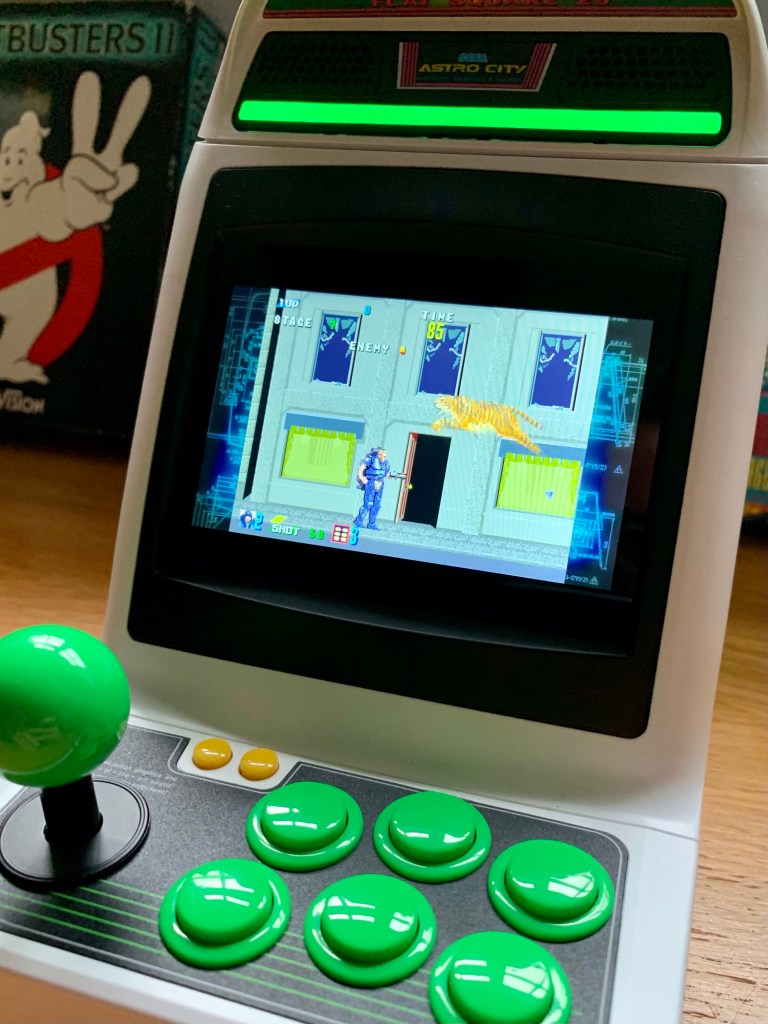
Scramble Spirits. I’ve never been massively keen on 1988’s Scramble Spirits. It’s another vertically-scrolling shooter, and I like the idea of being transported to a future fight in your World War II plane, but I’d rather be playing 1942 for World War II planes, or Xenon 2 for time travel, or probably a dozen others (including the aforementioned Sonic Boom) than this one. There’s some nice touches, like the comrade fighters you can pick up then direct to go kamikaze, or the close-up violence that signals an approaching level boss, but all the same, it’s a bit simplistic and a bit average as these things go. Good for the odd game when you haven’t for a while, but not one I’ll be firing up regularly.
Wonder Boy III: Monster Lair. Not to be confused with Wonder Boy III: The Dragon’s Trap (and that’s another can of worms I’m not opening!), this is the third Wonder Boy in the series, arriving in 1988 minus all that RPG stuff from its predecessor. This plays like a beefed-up Wonder Boy, and I don’t just mean all the weapon power-ups, but everything you’re seeing and hearing too. The arcade-platforming feels great, and I’m glad not to be wondering what I’m supposed to do with all these golden coins because all the text is in Japanese! Fantastic fun, and when I’ve properly rinsed the first game at least, I can definitely see myself spending a lot more time here.
Gain Ground. “An epic war that straddles time” isn’t the first thing I’d call it, but the idea is that you are one of twenty commandos dumped in the Dark Ages, and you’re fighting your way to an exit in each stage to move further ahead in time, totalling 40 stages in different time periods to fight your way through to get back to the future. All the commandos are playable individually, with different abilities and weapons, and you’ll mostly encounter the next one when you die, though you can pick them up as captives in some levels and switch around, and the same with any previously killed dudes. But who cares what that really means! This plays like a rubbish version of Commando, minus the scrolling, any discernable character because everything is so tiny, the great soundtrack or any fun whatsoever… The worst of it is the speed you’re getting spears chucked at you in the early levels though; a snail would come at you faster! This one stinks I’m afraid!
Crack Down. Top-down too, like a run and gun Gauntlet, released in 1989 though I do remember it on Mega Drive a bit later too. Anyway, you’re an agent shooting cyborgs and planting bombs at various points around each level as a timer counts down, on the hunt for a mad scientist up to no good as usual. Very clean-looking game with some nice animation giving everything plenty of character despite it all being on the small side. Loads of fun too, with some cool tactical possibilities and fun weapon pickups. Top-down done right and we’re back on form again!

Golden Axe. The legendary side-scrolling fantasy brawler from 1989 that might have been released on a hundred systems since, but I reckon it’s never felt better to play it at home than it feels here. It’s just great, and I’d even go as far as saying it’s a system seller for Astro City Mini. And yes, the dwarf does actually have a golden axe in this version, though, as always, the titular Golden Axe that belongs to the evil Death Adder is actually brown!
Cyber Police ESWAT. It all starts out as a fairly bland and relatively straightforward 1989 side-scrolling shooter and sometimes brawler and sometimes platformer, like a cop show version of Shinobi, Things really pick up around level three though, when you become Robocop and the enemies start to pick up steam too, with stuff like flamethrowers, grenades, tigers(!) and TNT that causes buildings to collapse as you’re scrambling up each floor. The environments pick up a bit here too, moving from generic urban decay to, well, more interesting urban decay! Has never blown me away, but it’s fun in short bursts.
Shadow Dancer. More Shinobi in this 1989 arcade sequel that I think was as far as Shinobi ever got in the arcades. This time he’s out to take down a terrorist organisation and save the day again, but now he’s got a ninja dog to help him out. It feels like the original, and you’ll still be being sent back to the start of the stage over and over again with its frequent, harsh one-hit kills. Sending out your dog to wrestle an upcoming baddie will buy you some throwing star time to counter this a bit, but leave it wrestling too long and it will get overpowered and go back to being a useless puppy! Otherwise, there’s a bit more to the backgrounds, but mostly a lot more Shinobi.
Alien Storm. Blimey, where to begin with this? We’re now entering the nineties, with a mostly Double Dragon kind of brawler, but you’re clearing the streets of aliens with a too short range ray-gun. It looks better than it plays at this point, and it’s certainly not a high point of the genre. Get far enough though, and you’ll either jump into an auto-running shooter that’s great fun but all too brief, or you’ll get an Operation Wolf-style hostage rescue in various shops, which is even more fun! And it’s all voiced by a wannabe Duke Nukem. I like it’s ambition a lot more than playing it unfortunately.
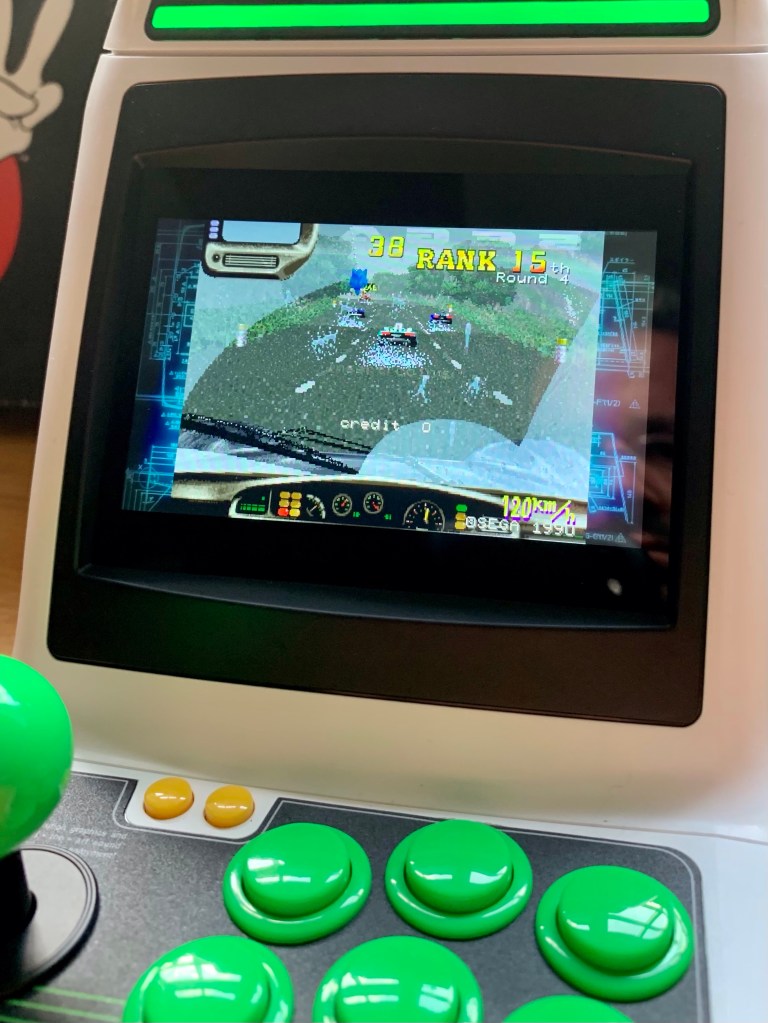
Columns. First game in the series (which we’ll be back to later), also from 1990, where you’re in jewel-based combat to place three or more horizontally, vertically or diagonally. I’ve not mentioned the Japanese text problem for a while because where it has appeared, it hasn’t mattered, but this one is a curious case of English and Japanese, even within the same screen! Anyway, it’s the classic falling block match-three, with a neat mechanic that allows you to change the order of the three jewels in your block as it falls. And as always, it’s really good, feels great to play here, and that chip tune church organ soundtrack never gets old!
Bonanza Bros. Another mix of English and Japanese, with the latter causing problems now because were missing out on everything important, from instructions to character conversations. Fortunately, it’s not rocket science, and a bit of trial error will have you getting almost the most out of this 1990 side-scrolling 2D cartoon arcade stealth shooter. You’re a burglar working your way through some light platforming to reach the treasure, avoiding or taking out guards. I’m not a fan of stealth, but I like how they use it here to make gameplay more about planning the next few seconds than fast reflexes. Definitely worth your time getting to know despite the language-based laziness.
Columns II. More of the same, also from 1990, but a bit more polished and we’ve now got two game modes to choose from. Flash Columns sets you challenges on a pre-populated set of jewels where you have to match-three your way to flashing objects and eliminate them to progress. Then there’s Vs Columns, where you’re building combos to make an opponent’s life more difficult by raising their playing field. No complaints about more Columns here from me when it’s this good. Yet…
Thunder Force AC. Not just one of my favourite horizontal shooters ever (maybe tied with P-47), but one of my favourite games full stop. I play it all the time when I’ve got a few minutes to spare, and now I’ve not only got somewhere else to play it, but I’ve got possibly the ultimate way to control it too! I love most of the Mega Drive Thunder Forces, and this one is a 1990 arcade rebuild of III on there, with elements of II and some ideas of it’s own, and the only thing that could possibly make it better is IV’s soundtrack! Absolutely thrilled to have this on here!

Rad Mobile. This is a really cool inclusion in the Astro City lineup! It’s a fairly obscure arcade racer from 1991 that only ever got a dodgy Saturn port. It plays like Out Run meets Power Drift (both of which would have been jaw-dropping inclusions here!), with a touch of Test Drive II’s hassle from the law thrown in. As much as it innovates on Out Run and Power Drift with things like weather effects, night and day, and the resulting windscreen wiper and headlight buttons, it’s not as much fun as either. The collision detection is even more dodgy than its Saturn port, which often works in your favour, but unless you’re pumping in credits the stage time limits demand a bit too much perfection given the tools at your disposal. All that said, I’m always thrilled to get my hands on a new nineties arcade racer and there’s a lot more playtime left in this one yet. You’ll also see the debut of a certain hedgehog too, dangling from your rear view mirror!
Cotton. Of all the games included here, this 1991 witchy cute ‘em up was probably the biggest draw of the lot when I placed my Astro City Mini preorder! It was the very first game I fired up and is certainly the one I’ve played more than any other since it arrived, mostly because I’ve wanted to get my hands on this since I first saw a screenshot back in 1991, and now, thirty years on, here we are! By coincidence, as I write this, I’ve also just beaten (but only scratched the high-scoring surface) the brand new Cotton Reboot (big review here), but I love all versions equally! Anyway, you’re a witch on the hunt for candy, and by taking down the supernatural anime masses standing between you and it, you’ll also be returning light to the Halloween world. Great aesthetic, and challenging but very addictive (and mostly accessible for an arcade shooter). And my system highlight!
Arabian Fight. I was a little dismissive of this the first time I played it – felt more style than substance. It’s a scrolling brawler from 1991 that seems to be based on the old Sinbad movies, but uses this really impressive sprite scaling technique to give perspective in and out of the screen. Also unique is the action seamlessly zooming in up close at the front of the screen for big enemy entrances or some special moves. The brawling itself doesn’t feel as good as something like Streets of Rage, but give it a few goes to click and you’ll be treated to some lovely “Arabian” settings (explained by more Japanese text) and really cool supernatural enemies. A real highlight for me, being an Ancient Egypt nerd, was moving from outside some pyramids into a tomb, and seeing the flat 2D warriors in the wall paintings coming to life to fight, but still as flat 2D sprites against this clever sprite-scaled 3D environment. Not the best brawler ever, but definitely worth a play to experience the journey.
Golden Axe: The Revenge of Death Adder. This 1992 sequel has no problems delivering both style and substance, with familiar hack and slash gameplay getting a bit more depth, and the fantasy settings getting a whole lot more colourful and detailed. Not only that, but there’s so much life everywhere you look too, with subtle animation carrying on regardless of the brutal chaos happening everywhere. It’s all been given extra clout, there’s new depth to enemies, new mounts and weapons, multiple pathways, and the magic effects never get old. I’d never played this before, but I’ll be all over it now. Brilliant sequel to a legendary game.
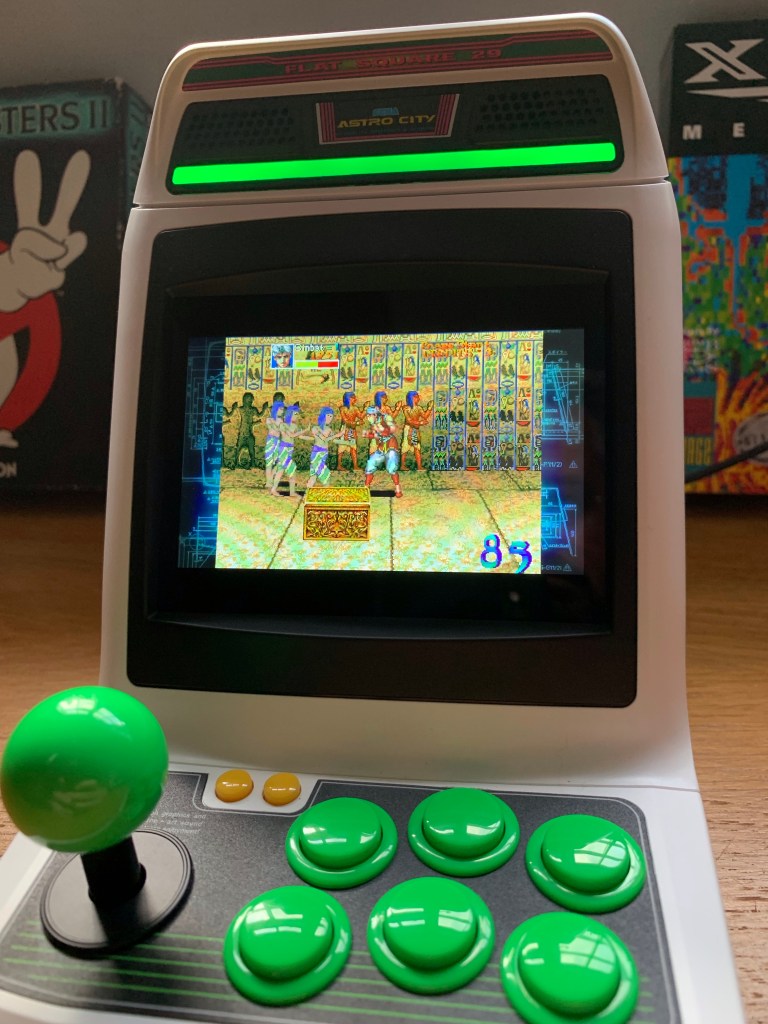
Puyo Puyo. If it wasn’t for my colourblindness, Puyo Puyo would probably be competing with Game Boy Tetris as my all time favourite falling tile (or Puyo in this case) matching puzzler. This one has two Puyos at a time falling from the top, and you’re spinning them around to build groups of four at the bottom, which will then disappear and eventually cause blockers to fall on your computer or human opponent’s side of the screen, effectively making them start again a way up the screen until they can clear them. If they reach the top you lose. Wonderful game even if I don’t like the colour choices which can make it hard to distinguish Puyos when it gets frantic, and everything is now in Japanese, but all the same, a great inclusion here.
Dark Edge. By 1993, 3D had become really, really 3D, as showcased by the super-deep 3D environments in this post-apocalyptic fighter. This means your super-scaled fighter sprites don’t just get bigger and smaller and you move in and out, but the fighting is coming from eight directions too. I’m guessing this was a fairly early, not to mention pioneering example of the genre, though the gameplay was familiar by now – work your way up the martial arts tournament ladder to its bosses in a series of best-of-three matches. As far as I know, this is the first time it’s made a home appearance here, so it’s very welcome and it’s not bad either.
Tant-R. This is a Bonanza Bros. spin-off from 1993, offering a load of timed mini-games featuring Detective Bumpy and other characters from the original game. You’ve got puzzle games like sliding tiles to reveal pictures; there’s counting games, concentration games, hidden objects and more. And while it’s well presented and seems to offer lots of variety, the whole thing is in Japanese, making its appearance here mostly pointless! You can work out most of the games yourself, but why you’re playing them will still be a mystery, so I’ve played this once and given it one more chance, but I doubt I’ll be back a third time.
Virtua Fighter. It’s another groundbreaker from 1993, with its big 3D environments and even bigger 3D polygon fighters. My brother had this (or the sequel – I forget) on his Mega Drive, so I got to know the ins and outs of the admittedly relatively simple control scheme pretty well. Not that it’s doing me any good here as I’ve not been particularly great at any fighter since IK+ on Atari ST! Anyway, this is still a great fighter and loads of fun to play even if it’s been a bit superseded since. That world’s first 3D will still bring a smile to your face too! Love that this was included on the console!
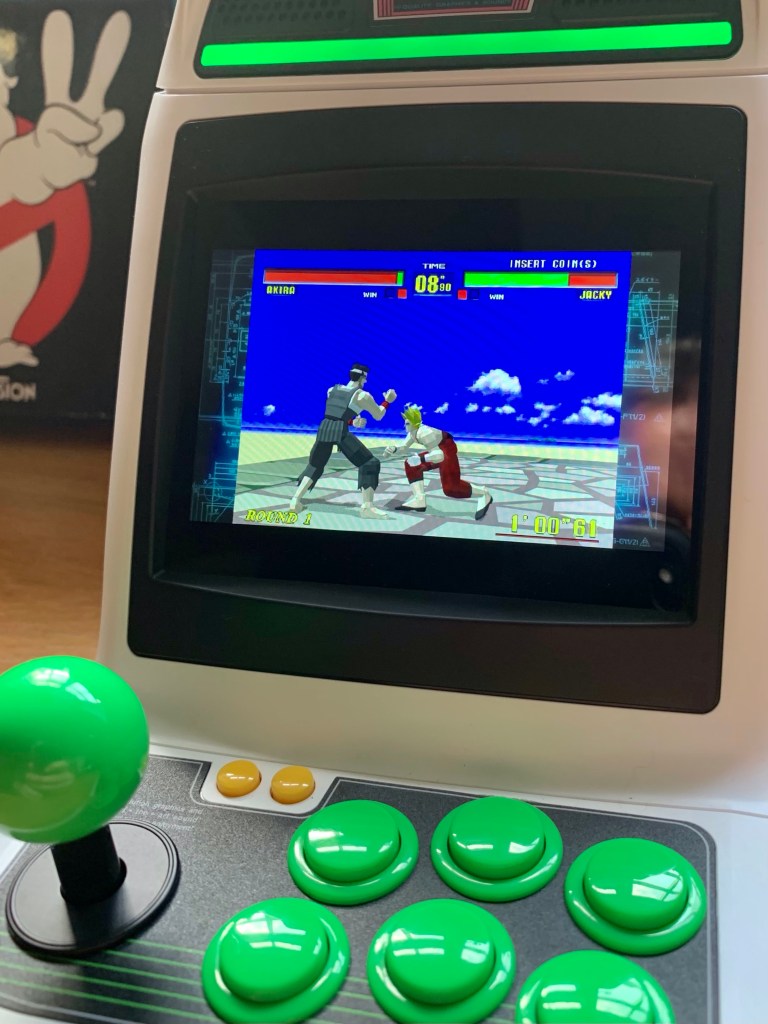
Stack Columns. I’m not a huge fan of this for several reasons… more Japanese text and more Columns being two of the main ones. There’s a bit of a Las Vegas gambling theme too, and that does nothing at all for me either. Now, I know this never got a home port and it’s never been easy to access, but I’m not sure we needed another Columns arcade game in 1994, and we certainly don’t need another one here! I know we’ve mentioned a couple of Sega racers not present, but how about a Thunder Blade or an Afterburner instead of a third Columns game, for example? Anyway, the game itself plays fine, there’s some new mechanics and its very slick if more Columns is your bag!
Ichidant-R. Oh no, it’s more Tant-R from 1994! We should have stuck at Virtua Fighter. This time the Bonanza Bros. seem to be medieval knights, working their way through a load more puzzles and mini-games. It’s all bigger in scope and scale this time, which I’m sure is great if you speak Japanese, but that means working out what the hell is being asked of you if you don’t is even harder this time around, which I have no patience for, so I’m out!
Puyo Puyo 2. Another case of absolutely no need for this 1994 sequel to be here. There’s some graphical enhancements, though some of them involve lots of ornate black on red backgrounds, compounding the colourblindness problems I have with the original even further, but mainly there’s some tweaks to chucking garbage over the wall to block your opponent’s progress, and a new offset counter move. Unfortunately that doesn’t offset the missed opportunity for another game instead, but on the plus side, at least it’s more of a good thing.
Dottori Kun. In case you’re afraid we’re going out on a damp squib, don’t be! Our final game, number 37, Dottori Kun (or Dot Race) is a proper curio from 1990, but as a fan of the very early pre-Pac-Man dot collecting maze game Head On (and more so its VIC-20 offshoot Bullet by Mastertronic and many years later Dodge ‘Em on Atari 2600), I’m all in on this! Its original purpose is a little unclear , but it seems to have been provided as either an Astro City system test board or a way of getting around a Japanese law requiring arcade boards to be supplied with games. Either way, it’s very primitive, with your arrow moving around the maze collecting dots and avoiding X which will kill you. No sound, no colour, no scores and almost no gameplay, but it will make you want to party like it’s 1979!
You still here? I started this because there’s always a risk with these machines that you play a few favourites, dabble with a few others and then consign it to gather dust. That said, I hadn’t quite thought through the epic undertaking of reviewing all 37 games, but I’m glad I did, though being the retro nerd I am, there was no risk of letting this gather dust! It’s small, perfectly formed and just feels fantastic. Yes, there’s a few superfluous sequels, and I am annoyed about the laziness of not providing English ROMs, especially where needing to read text is a bit of a given, but there’s a hell of a lot to discover and enjoy besides!
This lives on the desk in my study, and whenever I need a break from work I’ll switch it on for ten minutes. I’ve spent a good few whole evenings on stuff like Cotton, Thunder Force and Golden Axe too! Fantastic machine, fantastic journey of discovery so far, and I can’t recommend it enough but don’t just take my word for it… Check out my friend Jamie Elliot’s opinions, as well as a demo video, at Retro Overload, right here!

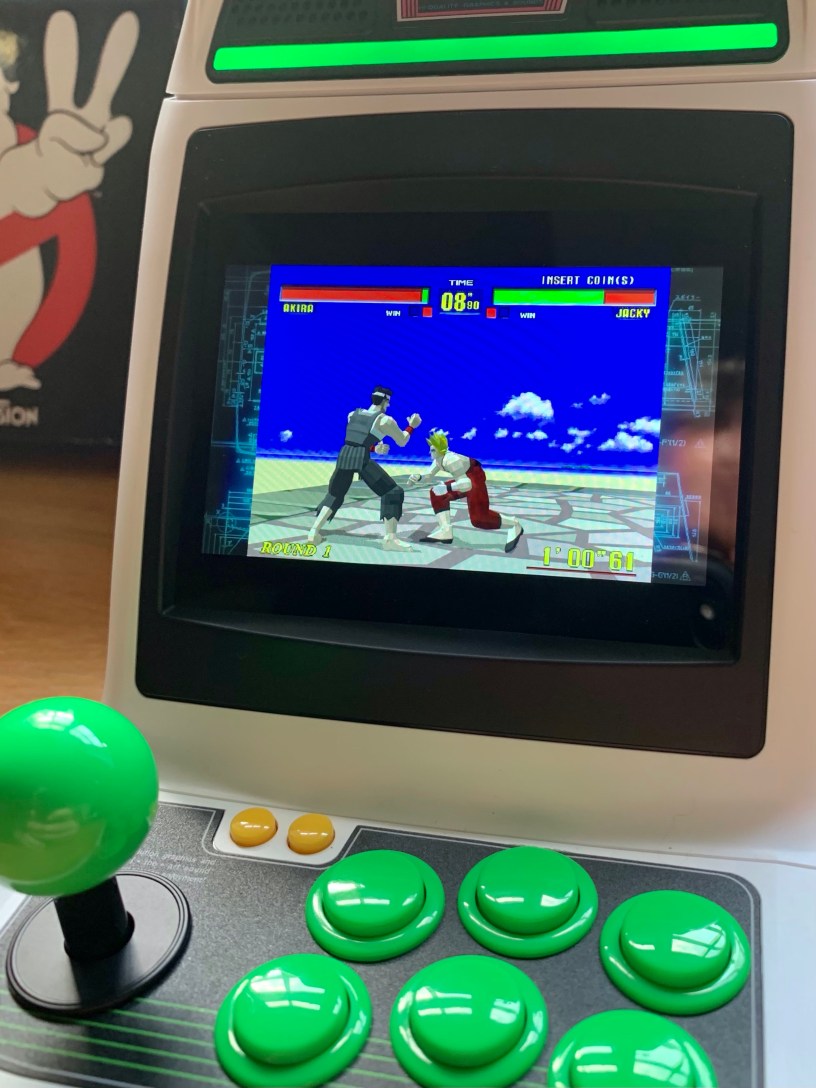
Reblogged this on DDOCentral.
LikeLike